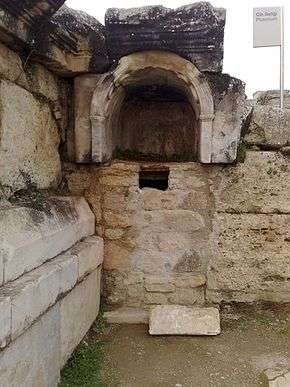Ploutonion at Hierapolis
|
Πλουτωνειον (Ancient Greek) Plutonium (Latin) | |
 The ruins of the Ploutonion at Hierapolis | |
 Shown within Turkey | |
| Location | Pamukkale, Denizli Province, Turkey |
|---|---|
| Region | Phrygia |
| Coordinates | 37°55′36″N 29°07′34″E / 37.92667°N 29.12611°ECoordinates: 37°55′36″N 29°07′34″E / 37.92667°N 29.12611°E |
| Type | Sanctuary of Pluto |
| Part of | Hierapolis |
| History | |
| Material | Stone |
| Founded | 2nd century BC |
| Abandoned | 6th century AD |
| Cultures | Ancient Greek, Ancient Roman |
| Site notes | |
| Excavation dates | ? - March 2013 |
| Archaeologists | Francesco D'Andria |
| Condition | Ruined |
The Ploutonion at Hierapolis (Ancient Greek: Πλουτωνειον, lit "Place of Pluto"; Latin: Plutonium) or Pluto's Gate[1] was a ploutonion (a religious site dedicated to the god Pluto) (another name for the god Hades) in the ancient city of Hierapolis near Pamukkale in modern Turkey's Denizli Province. The site was discovered in 1965 by Italian archaeologists, who published reports on their excavations throughout the decade.[2] In 2013, it was further explored by Italian archaeologists led by Francesco D'Andria, a professor of archaeology at the University of Salento.[3]
History
Though the exact age of the site is currently unknown, the nearby city of Hierapolis was founded around the year 190 BC by the King of Pergamum, Eumenes II.[3]
The site is built on top of a cave which emits toxic gases, hence its use as a ritual passage to the underworld. Ritual animal sacrifices were common at the site. Animals would be thrown into the cave and pulled back out with ropes that had been tied to them. Archaeologists noted that the fumes emitted from the cavern still maintain their deadly properties as they recorded passing birds, attracted by the warm air, suffocated after breathing the toxic fumes.[3]
The Ploutonion was described by several ancient writers including Strabo,[4] Cassius Dio and Damascius . It is a small cave, just large enough for one person to enter through a fenced entrance, beyond which stairs go down, and from which emerges suffocating carbon dioxide gas caused by underground geologic activity. Behind the 3 square metres (32 sq ft) roofed chamber is a deep cleft in the rock, through which fast flowing hot water passes releasing a sharp smelling gas.[3][5] Because people died in the gas, people thought that the gas was sent by Pluto, god of the underworld.
During the early years of the town, the castrated priests of Cybele known as the Galli descended into the Ploutonion, crawled over the floor to pockets of oxygen or held their breath. Carbon dioxide is heavier than air and so tends to settle in hollows. They then came up to show that they were immune to the gas. People believed a miracle had happened and that therefore the priests were infused with superior powers and had divine protection.[4][6]
An enclosed area of 2,000 square metres (22,000 sq ft) stood in front of the entrance. It was covered by a thick layer of suffocating gas, killing everyone who dared to enter this area. The priests sold birds and other animals to the visitors, so that they could try out how deadly this enclosed area was. Visitors could (for a fee) ask questions of the oracle of Pluto. This provided a considerable source of income for the temple. The entrance to the Ploutonion was closed off during the Christian times.[3]
The ancient historian Strabo described the gate as follows:
- "Any animal that passes inside meets instant death. I threw in sparrows and they immediately breathed their last and fell"[4]
Destruction
Archaeological evidence suggests that the site was fully functional until the 4th century AD, but remained a place of sporadic visitation by visitors for the next two centuries. The temple was destroyed in the 6th century AD by Christians, while later earthquakes may have further damaged the site.[3]
References
- ↑ D'Andria, Francesco. "Gate to Hell Found in Turkey". Discovery News 29 March 2013. Accessed 1 June 2013.
- ↑ Piccardi, Luigi (2007). "The AD 60 Denizli Basin earthquake and the apparition of Archangel Michael at Colossae (Aegean Turkey)". In Piccardi, L.; Masse, W. B. Myth and Geology. Special Publication. 273. Geological Society of London. p. 98. ISBN 978-1-86239-216-8.
- 1 2 3 4 5 6 Lorenzi, Rossella (29 March 2013). "Pluto's Gate Uncovered in Turkey". Discovery News. Retrieved 2 April 2013.
- 1 2 3 Strabo, Geographica 13.4.14
- ↑ Bean, G. E. (1976). "Hierapolis (Pamukkale) Turkey". In Stillwell, Richard; MacDonald, William L.; McAlister, Marian Holland. The Princeton Encyclopedia of Classical Sites. Princeton, NJ: Princeton University Press.
- ↑ Pliny the Elder, Naturalis Historiae 2.95
Further reading
- Ramsay, William M. (2004). The Cities And Bishoprics Of Phyrgia: Being An Essay Of The Local History Of Phrygia From The Earliest Times To The Turkish Conquest. Kessinger Publishing. p. 86. ISBN 9781419172830.
- Francesco D´Andria, Cehennem'den Cennet'e Hierapolis (Pamukkale). Ploutonion. Aziz Philippus'un Mezarı ve Kutsal Alanı. Ege Yayınları, Istanbul 2014. ISBN 978-605-4701-45-2